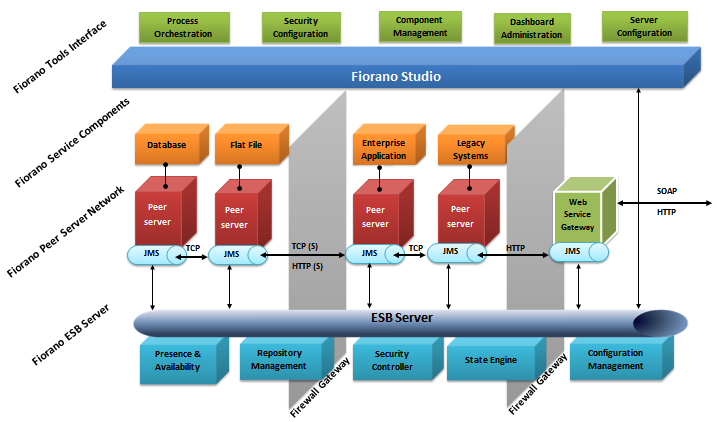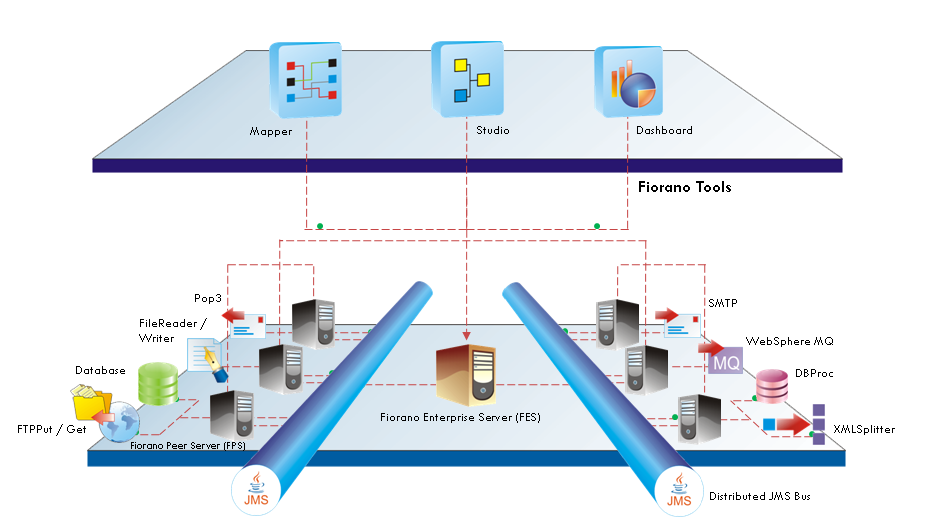...
This section explains the high-level system architecture of the Fiorano Enterprise Services Grid, which consists of Peer Service - Containers installed across the network together with the centralized Management and Repository Server as well as Management tools. The topics discussed in this chapter include the ESB Server, ESB peers, the Web-Gateway that manages Web-Services and Fiorano Orchestration and Management tools.
Fiorano System Architecture
...
- Fiorano Peer Server Network
- Fiorano ESB Enterprise Server
- Fiorano Service Components
- Fiorano Tools Interface
Figure 1 illustrates how different entities of the platform interact with each other in carrying out their respective functionalities.

Figure 1: The Fiorano System Architecture
- The Fiorano Peer Server Network is the Enterprise Class, centrally managed Peer-to-Peer messaging backbone.
- The Fiorano ESB Server is the Administration Gateway to the ESB Peer Server network.
- The Fiorano Service components are either the interfaces to units of the Enterprise IT Infrastructure or implementations of commonly used integration elements (such as transformations, content based routers, and so on). The Fiorano Service components implemented mostly in Java are either pure JMS or JCA components. Custom service components can be built in Java, C#, C or C++.
- The Fiorano Tools Interface is provided via the Fiorano eStudio which offers intuitive visual interfaces for the implementation of ESB Server rver capabilities for end Users.
...
ESB Server
...
The Fiorano ESB Server is the central controller of the Fiorano network. This control server acts as a monitoring agent for all other peers and ensures information coherence.
The various functions performed by the FES include:
- Control of launching as well as termination of Fiorano Components as part of an event process on any Peer of a Fiorano network.
- The update of status of all Peer Servers, Business Components and Event Processes running on Peers across the network.
- The Launch of a Business Component on a backup node, in case the primary FPS on which the Business Component is running goes down.
Fiorano Peer Server
The Fiorano Peer is a container for launching business components at network end-points of a Fiorano network and manages the life cycle of the components. The following are key functionalities of the Fiorano Peer:
...
to Peer
...
Server
...
communication
All data communication at runtime in the ESB network happens in direct Peer to Peer fashion between among Peer Servers. Only control data flows between the Enterprise and the Peers. The types of control events handed by the ESB Server include service component state notifications, event process state notifications, HA events, document tracking events and so on.
ESB Component and Process Repository
The ESB Server manages the following repositories:
- The repository to maintain versions of registered and unregistered service components along with dependent resources and binaries.
- The Meta data information of the event processes in XML format.
- The repository of Peers in the ESB network and their configuration
Communicating with ESB Server
The ESB server is the single point of management and administration for the ESB network. The Fiorano eStudio acts as the visual interface to the ESB Server function for the End-User.
Installation
The Fiorano Platform is available in two editions:
- Enterprise Edition: The Enterprise Edition includes the Fiorano Enterprise Server, Fiorano Peer Server, Fiorano Adapters, and all the Fiorano tools.
- Workstation Edition: The Workstation Edition includes the Fiorano Peer Server and all the Fiorano tools. The Workstation Edition is not bundled with the Enterprise Server. This edition requires an Enterprise edition to be installed on the Fiorano Network.
The Enterprise and Workstation Edition are available free for a 45-day evaluation period. The evaluation versions contain all the features of the licensed versions. The use of this software is defined in the Fiorano End-User License Agreement.
Different Topologies
The Fiorano Peer-to-Peer distributed model provides unmatched flexibility in deciding installation topology. Users can decide on an installation topology based on various parameters:
- Availability of hardware
- Hardware configuration – RAM (Random Access Memory) and, CPU processing
- Expected system performance
- Number of licenses available
The exact topology architecture for each solution varies and is determined based on specific customer requirements.
...
Fiorano Platform installation (Enterprise Edition) can be installed on a single machine. The default Peer Server profile is configured to work with the Enterprise Server available on the local machine. As such, no further configuration (other than JVM settings, like setting the heap size) is needed to launch the Servers. The Fiorano eStudio also comes pre-configured with the local Machine Enterprise Server connectivity information.
A single machine installation is the simple and fast way to get acquainted with the software. If the single machine has more than the recommended RAM and processing capabilities, then the servers can be deployed on the same machine. However, if a large number of processes are required to run and the available hardware configuration does not support the memory requirements of the business process, then users have to consider distributed deployment of servers.
Enterprise Server on a Machine and Peer Servers on Separate Machines
Another popular installation strategy is to have a dedicated machine for the central controller – the Fiorano Enterprise Server. Peers can be distributed across other machines. With this approach it is possible to distribute the load across multiple mid-range machines as compared to using a single high-end machine.
For example, the Figure 2 illustrates an installation topology spread across five machines.
...
ESB Server
The Enterprise Server is the centralized management and repository Server which manages the various components of the Fiorano Network.
System Requirements
The ESB Server is a 100% Java product and can be deployed on any platform with a JRE version 1.5 or above. For optimum performance, a minimum of 1 GB RAM is recommended. A complete Enterprise Edition installation requires 600 MB of disk space.
Installation Steps
The windows installer is wizard driven on which the default installation directory can be configured. The non-windows installer includes a wizard driven approach or a tar file that can be easily unzipped into a directory and then untarred.
Solaris Platform installation instructions:
- Use gtar in Solaris to untar
- GNU tar is bundled as: /usr/sfw/bin/gtar
Check the link below for further information: http://forum.java.sun.com/thread.jspa?threadID=5106899&messageID=9363883
ESB Peers
The ESB Peer Server is a runtime container for service components. The Peers communicate with each other directly in a Peer-to-Peer method without going through the Enterprise Server.
System Requirements
The Peer Server is a 100% Java product and can be deployed on any platform with a JRE 1.7 version. For optimum performance a minimum of 1 GB RAM or above is recommended.
The actual RAM and the hard disk space required for deployment depends on the number of Business Services running on a single node, complexity of the Business Services deployed on a single node, CPU requirements by the Business Services, anticipated data flow, expected performance from the system, and so on.
Installation Steps
The Windows installer is wizard driven on which the default installation directory can be configured. The non-windows installer includes a wizard driven approach or a tar file that can be easily unzipped into a directory and then untarred.
Solaris Platform installation instruction:
- Use gtar in Solaris to untar
- GNU tar is bundled as: /usr/sfw/bin/gtar